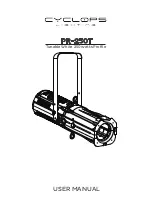
7
V1.47
If you are using controllers with this occupation, you can connect the DMX-output of the controller directly
with the DMX-input of the first fixture in the DMX-chain. If you wish to connect DMX-controllers with other
XLR-outputs, you need to use adapter-cables.
Building a serial DMX-chain:
Connect the DMX-output of the first fixture in the DMX-chain with the DMX-input of the next fixture.
Always connect one output with the input of the next fixture until all fixtures are connected.
DMX-512 connection with DMX terminator:
For installations where the DMX cable has to run a long distance or is in an electrically noisy
environment, such as in a discotheque, it is recommended to use a DMX terminator. This helps in
preventing corruption of the digital control signal by electrical noise. The DMX terminator is simply an
XLR plug with a 120 resistor connected between pins 2 and 3, which is then plugged into the output XLR
socket of the last fixture in the chain.
Caution: At the last fixture, the DMX-cable has to be terminated with a terminator. Solder a 120 Ω
resistor between Signal (–) and Signal (+) into a 3-pin XLR-plug and plug it in the DMX-output of the
last fixture.
Power connection
Power Requirements
The PR-250T zoom luminaire operates on 100 to 240 volts AC (+/- 10%, auto-ranging). The luminaire
contains an auto-ranging power supply.
Power linking between fixtures:
The fixture with powercon in and out socket. Connect the power out to the power in socket in the next
fixture till all are connected.
Caution: maximum power linking - 6 units.
Connection with the mains:
Connect the device to the mains with the enclosed power supply cable.
The occupation of the connection cables as below:
Cable color
Connection
International
Brown
Live
L
Blue
Neutral
N
Yellow/green
Earth(Ground)
Operation
The PR-250T zoom can operate in three different modes. In each mode you can run the fixture as a
stand alone fixture or in a master/slave confiugration. This next section will detail the differences in the
operating modes.

































